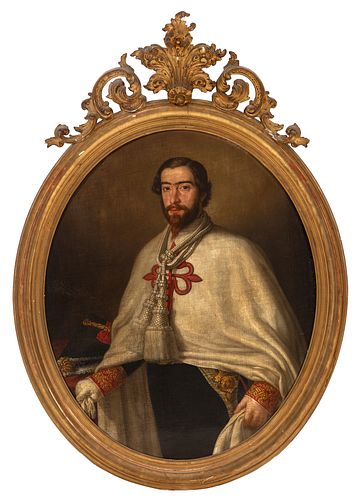Circle of FEDERICO DE MADRAZO Y KUNTZ (Rome, 1815 - Madrid, 1894). "Portrait of a gentleman belonging to the Order of Santiago", c. 1850. Oil on can
Lot 66
About Seller
Setdart Auction House
Carrer Aragó 346
Barcelona
Spain
Setdart Subastas was born in 2004 and is currently the first online art auction in Spain with solidity, prestige and reliability guaranteed by our more than 60,000 users. Setdart has a young, dynamic and enterprising team ready to successfully manage the purchase and sale of art works through custom...Read more
Estimate:
EUR€6,000 - EUR€7,000
$6,451.61 - $7,526.88
Absentee vs Live bid
Two ways to bid:
- Leave a max absentee bid and the platform will bid on your behalf up to your maximum bid during the live auction.
- Bid live during the auction and your bids will be submitted real-time to the auctioneer.
Bid Increments
| Price | Bid Increment |
|---|---|
| EUR€0 | EUR€10 |
| EUR€200 | EUR€25 |
| EUR€500 | EUR€50 |
| EUR€1,000 | EUR€100 |
| EUR€3,000 | EUR€200 |
| EUR€5,000 | EUR€500 |
| EUR€10,000 | EUR€1,000 |
| EUR€20,000 | EUR€2,000 |
| EUR€50,000 | EUR€5,000 |
About Auction
By Setdart Auction House
Nov 10, 2021
Set Reminder
2021-11-10 08:00:00
2021-11-10 08:00:00
America/New_York
Bidsquare
Bidsquare : 19th & 20th Century paintings and Decorative Arts
https://www.bidsquare.com/auctions/setdart-auction-house/19th-20th-century-paintings-and-decorative-arts-7800
Setdart Auction House sofia@setdart.com
Setdart Auction House sofia@setdart.com
- Lot Description
Circle of FEDERICO DE MADRAZO Y KUNTZ (Rome, 1815 - Madrid, 1894). "Portrait of a gentleman belonging to the Order of Santiago", c. 1850. Oil on canvas. It presents slight jumps in the painting. Measurements: 101 x 82 cm; 140 x 100 cm (frame). Oval portrait whose protagonist is shown to the viewer through a long bust, and very slightly turned because despite his posture highlights its rigidity that seems to give some frontality with respect to the viewer. The most remarkable thing about his figure is his clothing, where we can see the large cross that indicates his membership in the order of Santiago. Proud of his rank, he wears a white cloak that highlights the vermilion of his cross and therefore his social status. A characteristic- In this portrait, as in the rest of Federico de Madrazo's production, the author emphasizes the personality of the protagonist, making a psychological study of the model. He applies a short and precise brushstroke on the drawing, bringing luminosity to the flesh tones. Son of the painter José de Madrazo, who was also in Rome at the service of Charles IV in exile, Federico de Madrazo moved with his family to Madrid when his father was appointed painter of Fernando VII's chamber in 1819. Shortly thereafter, the Royal Museum of Paintings was inaugurated, an institution that would be a key element in the life of Federico de Madrazo. During his childhood and youth he visited it frequently with his father, who was in fact responsible for the lithographic establishment of the museum from 1826, and its director between 1838 and 1857. A precocious painter, Federico de Madrazo was admitted as an academician of merit in the Royal Academy of Fine Arts of San Fernando when he was only sixteen years old. During these years of youth he founded with his brother Pedro the magazine "El Artista", which was an important romantic novelty, and in which Federico was in charge of the illustrations. In 1832 he went to Paris to study painting with Ingres, a friend of his father. There he acquired a romantic style in the French manner. In 1840 he continued his training in Rome, where he came into contact with the Nazarenes and, in particular, with Overbeck, which strengthened his drawing skills, already important in his style thanks to what he had learned from his father and Ingres. An illustrative work about this Nazarene influence in Madrazo is "Las MarÃas en el sepulcro". Two years later he returned to Spain, becoming a painter of great prestige, much sought after as a portrait painter by the aristocracy of Madrid. Chamber painter to Queen Isabella II, he was the great official portraitist of the time. His portraits were characterized by the simplicity and naturalness of his models, and by a distant serenity, intimately linked to the romantic feeling. He was also director of the Prado Museum, a position he held, albeit interrupted, for thirty years until his death. He also directed the Royal Academy of Fine Arts of San Fernando. He developed a brilliant career as a history painter and, especially, as a portrait painter, achieving great prestige in the artistic circles not only in Madrid, but also in Paris and Rome. His production evolves from a painting where the purism of the line and the careful detailing predominate towards a more fluid and spontaneous technique, of greater expressive depth. Federico de Madrazo is currently represented in the Prado Museum, the National Museum of the Palace of Versailles, the Museum of Fine Arts in Bilbao, the Lázaro Galdiano Foundation and the Romantic Museum in Madrid, among others.
- Shipping Info
-
In-house shipping available. Please inquire at admin@setdart.com.
-
- Buyer's Premium



 EUR
EUR CAD
CAD AUD
AUD GBP
GBP MXN
MXN HKD
HKD CNY
CNY MYR
MYR SEK
SEK SGD
SGD CHF
CHF THB
THB
















